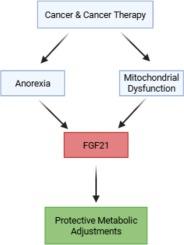The role of FGF21 in the metabolic adjustments required for exercise capacity
IF 5.1
2区 医学
Q1 MEDICINE, RESEARCH & EXPERIMENTAL
引用次数: 0
Abstract
Fatigue is one of the most common and persistent symptoms experienced by patients with various medical conditions. It is characterized by its enduring nature, lack of improvement after a good night's sleep, and interference with daily functioning. The mechanisms behind fatigue remain controversial. In cancer patients, inflammation and mitochondrial dysfunction appear to be the predominant contributors. Mitochondrial dysfunction results from oxidative stress and inflammation. This condition leads to the production and release of soluble mediators known as mitokines, which act in an autocrine, paracrine, and endocrine manner to help the body adapt to the changes in energy metabolism caused by mitochondrial dysfunction. The main mitokines include growth differentiation factor (GDF) 15 and fibroblast growth factor (FGF) 21. We have already gathered evidence highlighting the pivotal role of GDF15 in the behavioral fatigue that arises in response to chemotherapy. In this perspective article, we explore whether the existing knowledge about the role of FGF21 in metabolic adaptations during cellular stress positions this mitokine as a potential candidate for cancer-related fatigue. To do this, we summarize how FGF21 is produced at the level of each organ involved in energy metabolism and how its local and distant effects may influence the capacity to engage in energy-intensive activities such as physical exercise.

FGF21在运动能力所需的代谢调节中的作用
疲劳是各种疾病患者最常见和持久的症状之一。它的特点是它的持久性,一夜好眠后缺乏改善,并干扰日常功能。疲劳背后的机制仍然存在争议。在癌症患者中,炎症和线粒体功能障碍似乎是主要因素。线粒体功能障碍由氧化应激和炎症引起。这种情况导致被称为分裂因子的可溶性介质的产生和释放,它以自分泌、旁分泌和内分泌的方式起作用,帮助身体适应线粒体功能障碍引起的能量代谢变化。主要的分裂因子包括生长分化因子(GDF) 15和成纤维细胞生长因子(FGF) 21。我们已经收集了证据,强调了GDF15在化疗反应引起的行为疲劳中的关键作用。在这篇前瞻性的文章中,我们探讨了关于FGF21在细胞应激期间代谢适应中的作用的现有知识是否将该分裂因子定位为癌症相关疲劳的潜在候选者。为此,我们总结了FGF21是如何在参与能量代谢的每个器官水平上产生的,以及它的局部和远距离效应如何影响参与能量密集型活动(如体育锻炼)的能力。
本文章由计算机程序翻译,如有差异,请以英文原文为准。
求助全文
约1分钟内获得全文
求助全文
来源期刊

Life sciences
医学-药学
CiteScore
12.20
自引率
1.60%
发文量
841
审稿时长
6 months
期刊介绍:
Life Sciences is an international journal publishing articles that emphasize the molecular, cellular, and functional basis of therapy. The journal emphasizes the understanding of mechanism that is relevant to all aspects of human disease and translation to patients. All articles are rigorously reviewed.
The Journal favors publication of full-length papers where modern scientific technologies are used to explain molecular, cellular and physiological mechanisms. Articles that merely report observations are rarely accepted. Recommendations from the Declaration of Helsinki or NIH guidelines for care and use of laboratory animals must be adhered to. Articles should be written at a level accessible to readers who are non-specialists in the topic of the article themselves, but who are interested in the research. The Journal welcomes reviews on topics of wide interest to investigators in the life sciences. We particularly encourage submission of brief, focused reviews containing high-quality artwork and require the use of mechanistic summary diagrams.
 求助内容:
求助内容: 应助结果提醒方式:
应助结果提醒方式:


